SAN DIEGO — Eighteen-year-old Vanessa Flores still remembers stumbling over her words on her second day at San Diego City College (SDCC) last fall when the Border Patrol agent in San Ysidro, a district in San Diego just north of the border, asked her where she was going. At first she thought about saying she was going up the coast to Oceanside to visit her grandmother. But all she could manage was that she was going to high school, and when he asked her which one, the only name that came to mind was “pirate” — the mascot of her school in Tijuana.
“He was doing his job,” said Flores, “but I got nervous.”
Wondering if they’ll say the wrong thing to officials is a daily reality for youth who cross the border to attend school, whether it’s high school or college. For Flores, so is waking up in the dark in order to reach the border by 7 a.m., getting on the trolley and making it to her 8 a.m. class on time. “You never know how long it’s going to take,” Flores said.
Transborder youth were often born in the U.S., may have lived on the U.S. side of the border at one point, and have spent their lives crossing the border to visit relatives or go shopping. But their families live in Tijuana, Mexico, largely because it’s more affordable. In K-12 schools, as well as in college, many families maintain or use an address in the U.S. to establish residency. “It’s like everyone in Mexico has an aunt here,” Flores said.
Crossing the border can be an isolating process. But now, as part of a photography program called Borderclick, Flores and other transborder youth are getting an opportunity to share their experiences with each other and perhaps provide the world a different image of Mexicans than the ones that flourished during the 2016 presidential campaign. Chants of “build a wall” contributed to negative perceptions of those who cross the U.S.-Mexican border — even if their reasons are positive.

Ale Uzarraga
“Trolley”
“The wall already exists,” said Rebecca Goldschmidt, a lead instructor with the AjA Project, which received funding from the California Arts Council for Borderclick. “We see it every day — we cross over it, and we understand the mental and physical anxiety that it causes.”
The AjA Project is a San Diego nonprofit that enables urban youth — especially those in underrepresented racial and ethnic minority groups — to speak out about issues in their communities by using photography.
With assignments such as capturing photos of a cultural symbol that helps to define them or expressing the emotions they feel when they cross the border through an abstract photograph, the students are collecting images that will become part of a large, public installation next summer at San Diego State University.
Flores took a photo of the trolley car. “To me, the trolley means independence,” she said.
Another student, Claudia Ortiz, took photos of her keys in different places, saying the keys represent opportunity.
The students’ work is also attracting attention from other artists and was featured in November at “Transnational Intersectionalities,” a binational research conference held one day at SDCC and the next day at El Colegio de la Frontera Norte (El Colef), a university in Tijuana about 25 miles away.
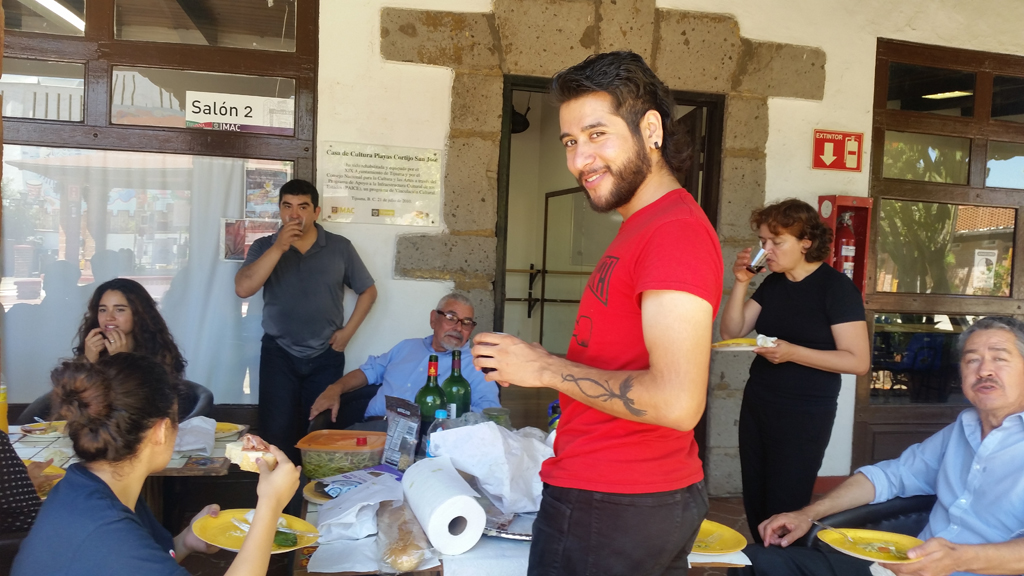
Aaron Diaz
“Familia”
“This is a community that is never really connected because they are so dispersed,” said Goldschmidt, who also lives a transborder life. “If you feel like someone is listening to you, you’re going to keep talking. My role is to help people discover themselves.”
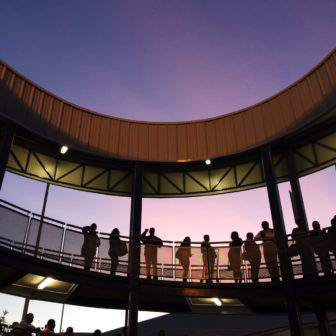
Vanessa Flores
“Caracol”
In addition, Goldschmidt and Josemar Gonzalez Lizarraga, also an instructor and a graphic artist, are recording all of the students’ conversations during their meeting and will compile that information along with the photographs to determine the final product. With the Border Patrol collecting data on everyone who crosses, Goldschmidt and Lizarraga see Borderclick as a way for young people to collect and analyze data on themselves. “It’s about reclaiming that data,” Lizarraga said.
Speaking out with photography
AjA is an acronym for Autosuficiencia Juntada con Apoyo, which in Spanish means supporting self-sufficiency. Through after-school programs, arts-integration programs in schools and in partnership with other organizations, AjA works with youth, from middle school through college age, to create public exhibits that explore issues of identity and change misconceptions about minority youth.
With a program called Collective Voices, for example, AjA collaborated with United Women of East Africa to involve 18 young Muslim women in a nine-month process of learning photography techniques and creating multimedia exhibits to display in places such as the Museum of Photographic Arts in Balboa Park, just north of SDCC.

Claudia Ortiz
“Llaves2”
In past years, artists and educators have led middle school students in an after-school program called PhotoCity, in which students use photography to document and call attention to issues they might not have otherwise discussed. For example, Monroe Clark Middle School students used photos to “map” places in their community where they had been bullied or felt scared to walk, as well as places that felt safe. They had the opportunity to speak at a community forum, and school administrators organized an anti-bullying week in response.
A misunderstood group
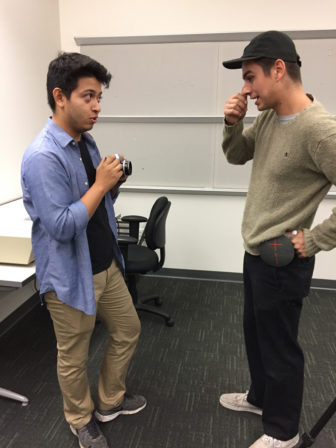
Photos by Linda Jacobson
Benjamin Corrales (left) and Alejandro Martinez chat before a Borderclick meeting.
How many young people live a transborder life? “There is not much out there,” says Vannessa Falcon, a Ph.D. student at San Diego State University who is working with Borderclick and has been crossing back and forth since she was 12. The lack of solid numbers is understandable, considering that many are reluctant to be honest about going home to Tijuana every night, Falcon said. But in a small qualitative study, she did learn about the myriad of reasons for crossing the border — sometimes daily. “Economic hardship,” “affordable living in Mexico,” and “to be with family in Mexico,” were top responses.
Andrea Morin, also a Borderclick student, had friends who began crossing the border every day so they could get a diploma from a U.S. high school and stand a better chance of being accepted to a four-year college. Her father, however, wanted her to finish school in Tijuana in case she decided to go to college there. She pushed for attending SDCC and dreams of transferring to a four-year school in New York City.
“He still sees me as this little kid,” she said.
Obstacles to education
For some students, the challenges associated with getting across the border to go to school can be a significant obstacle to their education. In a 2012 study appearing in Frontera Norte, a magazine from El Colef, Eunice D. Vargas-Valle examined the Population and Housing Census to learn more about educational issues among transborder youth. She found that while being born in the U.S. improves students’ chances of completing high school, being part of a transborder family has a negative effect on students’ chances of pursuing postsecondary education.
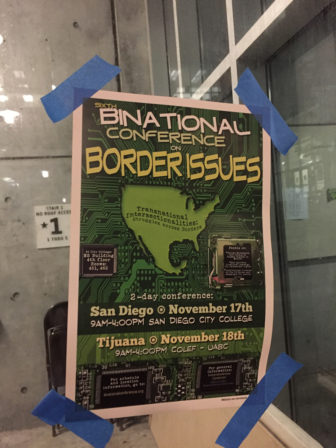
A flier publicizes a joint conference held at two colleges on both sides of the border.
“Transmigrants cross over into the United States to secure better paid jobs than they would have had in Mexico and continue living in Mexico to achieve lower living costs than in the United States and maintain their family and cultural links,” she wrote. “Although transborder employment supports certain families and provides substantial economic benefits for the zone, by negatively influencing young people’s aspirations, it could also be contributing to the perpetuation of border cities’ low educational levels.”
Under President Barack Obama, the Forum on Higher Education, Innovation, and Research was launched to strengthen the partnership between the U.S. and Mexico, encourage cooperation and create more educational and economic opportunities for underserved students. According to a statement released at the 2014 North American Leaders’ Summit, “the future success and competitiveness of our region depends on our ability to foster innovation, provide our citizens access to high quality educational opportunities and to technology, and promote a workforce with the skills necessary for success in the 21st century global economy.”
With Trump protests going on just a couple blocks from SDCC, however, the transborder community is now more apprehensive about what might result from his efforts to stop illegal immigration.
“Ever since the election, the environment has changed,” Morin says. “I felt it in the trolley. It felt really silent.”
Future plans for Borderclick include securing additional grant funding so that community forums, including policymakers, educators and developers, can be held to discuss changes the students would like to see. Having online classes or offering classes in Tijuana are a few of the changes that would make the students’ lives less complicated, Goldschmidt said.
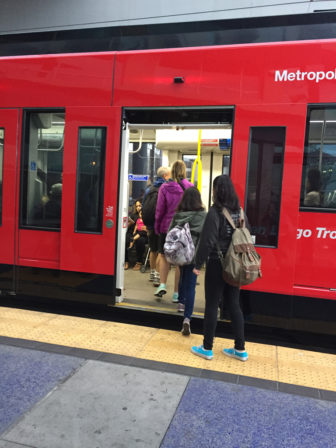
Vanessa Flores and Andrea Morin board the trolley.
Borderclick, she adds, is also an opportunity to better describe the unique aspects of life for those who grew up and live as part of two cultures, such as checking the Como Esta La Linea (How is the line?) Facebook group every day to see wait times at the border. For Flores, it means carrying two wallets—one for American dollars and one for Mexican pesos. Another student remembers as a child estimating how long it would take to cross by how far away she was from the towering, two-headed Trojan Horse sculpture that used to sit on the border.
Morin and Flores recognize that transitioning into college as a transborder youth comes with certain sacrifices. They haven’t spent much time getting to know other students at SDCC because they want to get back to the border before dark, where their parents pick them up. And they don’t go out with their friends in Tijuana because they have to get up so early.
“We can’t be entirely committed to either,” Morin said. “If it wasn’t for our friendship, we would feel really alone.”
Editor’s note: This story has been updated to correctly identify Frontera Norte, the magazine from El Colef, which contained information from a 2012 study regarding about educational issues among transborder youth.


























